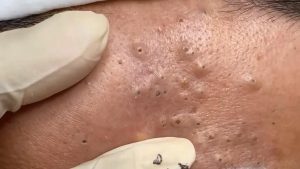My Favorite New Episode❤️ : 11 – BEST TIPS

Scroll down for the video 👇👇 What is a Cyst? A cyst is a benign, encapsulated lesion that consists of a fluid sac which contains liquid, or semi-fluid material. It can vary in shape, size and location. The most common types of cysts are reviewed here.
Acne, acne cysts, and sebaceous cysts are benign skin lesions and are one of the most common reasons which patients consult with dermatologists like Dr. Michele Green in Manhattan. Sebaceous cysts are the most common type of cyst, and are slow-growing noncancerous bumps on the skin. However, if sebaceous cysts are left untreated, they tend to enlarge, get infected, and cause cosmetic scarring. Dr. Michele Green treats these sebaceous cysts in her Upper East Side NYC office each day. Through her minimally invasive techniques, she treats these cysts in a cosmetically elegant way, and avoids any unnecessary scarring.
What causes a sebaceous cyst?
Sebaceous cysts are formed within the sebaceous gland, which is the gland which produces sebum. These cysts develop when the hair follicles become clogged due to a build up of sebum or keratin. These cysts can also be formed from pimples or as a result of trauma to the sebaceous glands. Individuals with a genetic predisposition such as steatocystoma multiplex, Gardner’s syndrome or Basal Cell Nevus Syndrome are also prone to developing sebaceous cysts.
How do you diagnose a sebaceous cyst?
A diagnosis of a sebaceous cyst can be determined by a physical examination of the nodule by a dermatologist, family physician or other healthcare provider. There are occasions when additional testing is required to make a definitive diagnosis of a cyst, since it can sometimes be mistaken for a different type of skin tumor.
Common tests used to diagnosis a sebaceous cyst include:
Cat scan – This test is performed to rule out other abnormalities or cancer.
Ultrasound – This test is performed to establish the contents of the cyst and depth of inflammation.
Punch biopsy – This test is performed to identify the histology of the cyst.
Culture and Sensitivity – This exam is performed to determine the type of bacteria responsible for the infection and the best antibiotic to treat the infection.
To prevent blackheads and large acne, follow these skincare tips:
Daily Skincare Routine:
-
Cleanse Twice a Day – Use a gentle cleanser with salicylic acid to remove oil, dirt, and makeup.
-
Exfoliate Regularly – Use a chemical exfoliant (like AHA/BHA) 2-3 times a week to unclog pores.
-
Use a Clay Mask – Once or twice a week to absorb excess oil and clear out blackheads.
-
Moisturize Properly – Choose a lightweight, oil-free moisturizer to keep your skin hydrated.
-
Apply Sunscreen Daily – Protect your skin from UV damage that can worsen acne.
Lifestyle & Habits:
-
Avoid Touching Your Face – Bacteria from your hands can clog pores and cause breakouts.
-
Clean Your Pillowcases & Phone – Dirt and oil from surfaces can contribute to acne.
-
Stay Hydrated – Drinking enough water helps flush out toxins.
-
Eat a Balanced Diet – Reduce dairy, sugar, and processed foods, which can trigger acne.
-
Manage Stress – Stress increases oil production, leading to breakouts.
Targeted Treatments:
-
Use Retinoids – They help prevent clogged pores and improve skin texture.
-
Spot Treat with Benzoyl Peroxide – This helps kill acne-causing bacteria.
-
Consider Professional Treatments – Chemical peels, facials, or extractions by a dermatologist can help.
Here are some great skincare product recommendations for preventing blackheads and large acne:
1. Cleanser (Salicylic Acid-Based for Deep Cleaning)
-
CeraVe Renewing SA Cleanser – Gentle and effective for daily use.
-
La Roche-Posay Effaclar Medicated Gel Cleanser – Contains 2% salicylic acid to unclog pores.
-
Neutrogena Oil-Free Acne Wash – Budget-friendly and helps reduce breakouts.
2. Exfoliator (Chemical for Unclogging Pores)
-
Paula’s Choice Skin Perfecting 2% BHA Liquid Exfoliant – Best for blackheads & acne-prone skin.
-
The Ordinary AHA 30% + BHA 2% Peeling Solution – Strong weekly exfoliation (use with caution).
-
COSRX BHA Blackhead Power Liquid – Gentle enough for sensitive skin.
3. Moisturizer (Lightweight & Non-Comedogenic)
-
Neutrogena Hydro Boost Water Gel – Hydrating but oil-free.
-
CeraVe PM Facial Moisturizing Lotion – Contains niacinamide to soothe acne.
-
La Roche-Posay Toleriane Double Repair Face Moisturizer – Lightweight and helps repair the skin barrier.
4. Sunscreen (Non-Greasy & Acne-Safe)
-
EltaMD UV Clear Broad-Spectrum SPF 46 – Great for acne-prone skin with niacinamide.
-
Biore UV Aqua Rich Watery Essence SPF 50+ – Lightweight and doesn’t clog pores.
-
La Roche-Posay Anthelios Melt-in Milk Sunscreen SPF 60 – Non-comedogenic and hydrating.
5. Targeted Acne Treatments
-
Differin Gel (Adapalene 0.1%) – A great retinoid for preventing clogged pores.
-
PanOxyl 10% Benzoyl Peroxide Wash – Strong acne-fighting cleanser for body & face.
-
The Ordinary Niacinamide 10% + Zinc 1% – Helps control oil and reduces inflammation.
6. Clay Mask (For Oil Control & Blackheads)
-
Innisfree Super Volcanic Pore Clay Mask – Helps absorb excess oil.
-
Aztec Secret Indian Healing Clay – Deep pore cleansing when mixed with apple cider vinegar.
-
Origins Clear Improvement Charcoal Mask – Detoxifies and clears pores.



